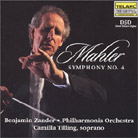May 2002
Mahler wrote the final movement of this symphony a full eight years before the rest. He had originally intended it to complete his third symphony. When he chose not to, he kept it, planning the Fourth Symphony to incorporate it. Benjamin Zander approached conducting the Fourth in a most refreshing way. Zander is a purist, hewing closely to the score in an attempt to shape a performance mirroring the composer’s intentions. My first encounter with Zander was his performance of Beethoven’s Fifth Symphony. Zander meticulously followed Beethoven’s metronome markings. In his rendition of Mahler’s Fourth, Zander again pays close attention to the composer's metric markings and dynamic instructions. The tempo is leisurely throughout, as though the Philharmonia were taking a stroll through the park. The timbre of the various instruments is kept distinct and clear. The enhanced clarity allows the listener to hear how individual sections and instruments start and stop together or, as is frequently the case, how some voices slow down as others pick up the pace. Individual performances are of the highest quality. Christopher Warren-Green brings the second movement, In gemachlicher Bewegung. Ohne Hast, to life, his violin providing a quite dramatic burst of color to the movement. In the final movement, Sehr behaglich, we are treated to soprano Camilla Tilling. Her rich, melodic voice perfectly illustrates that movement's "heavenly" theme. The recording is typical of Telarc’s latest DSD recordings: quiet, dynamic, detailed, extended -- everything about it begs to be used as demo material. Mahler's music is always full of surprises, but I must confess that the dynamic entrance of a drum or horn startled me on more than one occasion. Mahler would have been pleased. A real bonus is the addition of a second disc in which Zander discusses the Fourth in detail. I found it fascinating, and I suspect it will prove indispensable to those listeners just getting to know the composer’s work. They, like the rest of us, are lucky to have such a superb new choice added to the great performances of this oft-recorded masterpiece. GO BACK TO: |
 Mahler - Symphony No. 4
Mahler - Symphony No. 4![[Reviewed on CD]](../format/regcd.gif) Mahler’s
Fourth Symphony is a great starting place for listeners scared off by his more aggressive,
or what some might even consider schizophrenic, compositions. Most of Mahler’s
symphonies describe an unpredictable world of infinite possibilities filled with the
voices of delight and despair. More often than not, mirroring Mahler’s tragic life,
despair seems to take more of the spotlight. The themes of the Fourth are not really
different, but they are a little (maybe more than a little) easier to digest, like a
smooth merlot rather than a complex cabernet sauvignon.
Mahler’s
Fourth Symphony is a great starting place for listeners scared off by his more aggressive,
or what some might even consider schizophrenic, compositions. Most of Mahler’s
symphonies describe an unpredictable world of infinite possibilities filled with the
voices of delight and despair. More often than not, mirroring Mahler’s tragic life,
despair seems to take more of the spotlight. The themes of the Fourth are not really
different, but they are a little (maybe more than a little) easier to digest, like a
smooth merlot rather than a complex cabernet sauvignon.